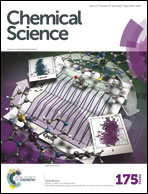Parallel folding topology-selective label-free detection and monitoring of conformational and topological changes of different G-quadruplex DNAs by emission spectral changes via FRET of mPPE-Ala–Pt(ii) complex ensemble†
Abstract
The formation of supramolecular assemblies between [Pt(bzimpy-Et){C![[triple bond, length as m-dash]](https://www.rsc.org/images/entities/char_e002.gif) CC6H4(CH2NMe3-4)}]Cl2 (1) and mPPE-Ala and the FRET properties of the ensemble have been revealed from the UV-vis absorption, steady-state emission and time-resolved emission decay studies. The two-component mPPE-Ala–1 ensemble has been employed in a “proof-of-principle” concept for label-free detection of G-quadruplex DNAs with the intramolecular propeller parallel folding topology, such as c-myc, in aqueous buffer solution. By the modulation of the aggregation/deaggregation of the polymer–metal complex aggregates and hence the FRET from the mPPE-Ala donor to the aggregated 1 as acceptor, the ensemble has been demonstrated for sensitive and selective label-free detection of c-myc via the monitoring of emission spectral changes of the ensemble. Ratiometric emission of the ensemble at 461 and 662 nm has been shown to distinguish the intramolecular propeller parallel G-quadruplex folding topology of c-myc from other G-quadruplex-forming sequences of different folding topologies, owing to the strong and specific interactions between c-myc and 1 as suggested by the UV-vis absorption and UV melting studies. In addition, the formation of high-order intermolecular multimeric G-quadruplexes from c-myc under molecular crowding conditions has been successfully probed by the ratiometric emission of the ensemble. The conformational and topological transition of human telomeric DNA from the mixed-hybrid form to the intramolecular propeller parallel form, as observed from the circular dichroism spectroscopy, has also been monitored by the ratiometric emission of the ensemble. The ability of the ensemble to detect these conformational and topological transitions of G-quadruplex DNAs has been rationalized by the excellent selectivity and sensitivity of the ensemble towards the intramolecular propeller parallel G-quadruplex DNAs and their high-order intermolecular multimers, which are due to the extra stabilization gained from Pt⋯Pt and π–π interactions in addition to the electrostatic and hydrophobic interactions found in the polymer–metal complex aggregates.
CC6H4(CH2NMe3-4)}]Cl2 (1) and mPPE-Ala and the FRET properties of the ensemble have been revealed from the UV-vis absorption, steady-state emission and time-resolved emission decay studies. The two-component mPPE-Ala–1 ensemble has been employed in a “proof-of-principle” concept for label-free detection of G-quadruplex DNAs with the intramolecular propeller parallel folding topology, such as c-myc, in aqueous buffer solution. By the modulation of the aggregation/deaggregation of the polymer–metal complex aggregates and hence the FRET from the mPPE-Ala donor to the aggregated 1 as acceptor, the ensemble has been demonstrated for sensitive and selective label-free detection of c-myc via the monitoring of emission spectral changes of the ensemble. Ratiometric emission of the ensemble at 461 and 662 nm has been shown to distinguish the intramolecular propeller parallel G-quadruplex folding topology of c-myc from other G-quadruplex-forming sequences of different folding topologies, owing to the strong and specific interactions between c-myc and 1 as suggested by the UV-vis absorption and UV melting studies. In addition, the formation of high-order intermolecular multimeric G-quadruplexes from c-myc under molecular crowding conditions has been successfully probed by the ratiometric emission of the ensemble. The conformational and topological transition of human telomeric DNA from the mixed-hybrid form to the intramolecular propeller parallel form, as observed from the circular dichroism spectroscopy, has also been monitored by the ratiometric emission of the ensemble. The ability of the ensemble to detect these conformational and topological transitions of G-quadruplex DNAs has been rationalized by the excellent selectivity and sensitivity of the ensemble towards the intramolecular propeller parallel G-quadruplex DNAs and their high-order intermolecular multimers, which are due to the extra stabilization gained from Pt⋯Pt and π–π interactions in addition to the electrostatic and hydrophobic interactions found in the polymer–metal complex aggregates.


 Please wait while we load your content...
Please wait while we load your content...